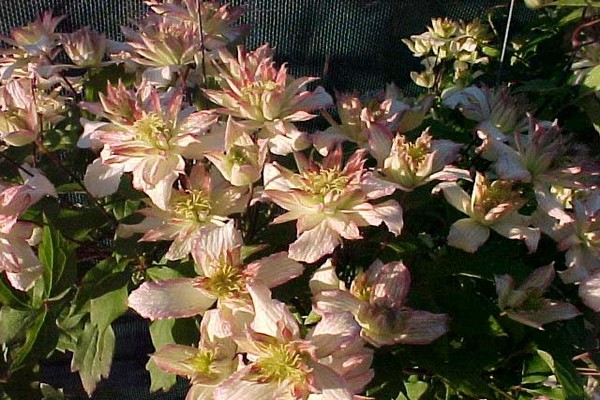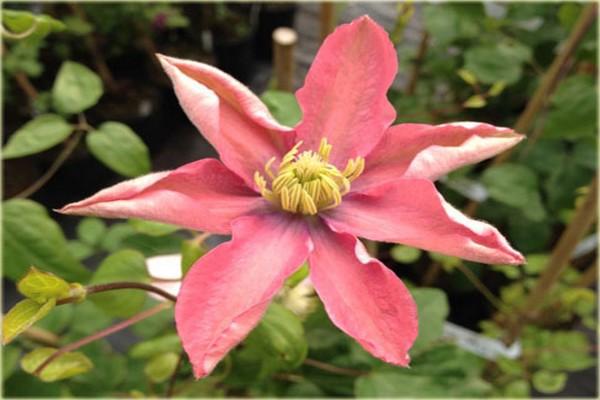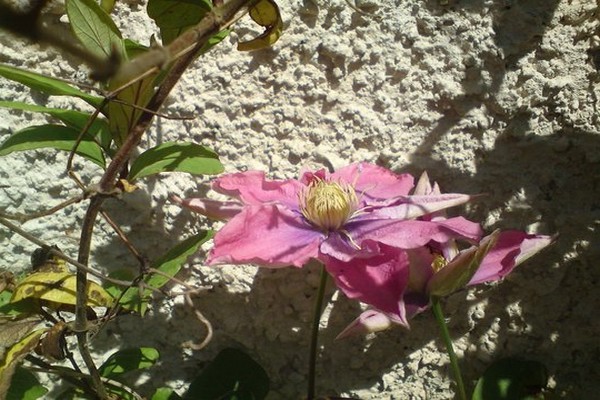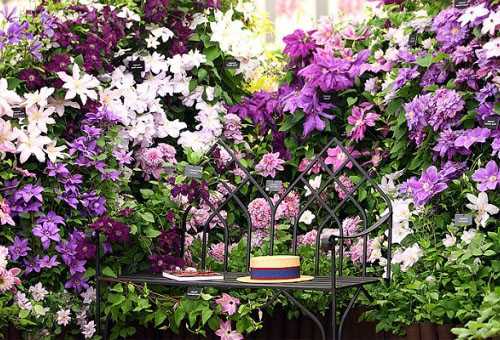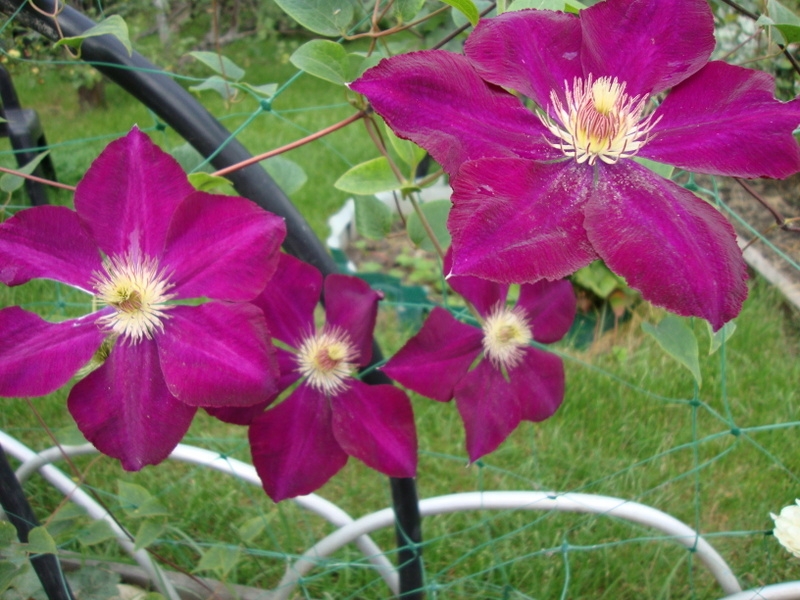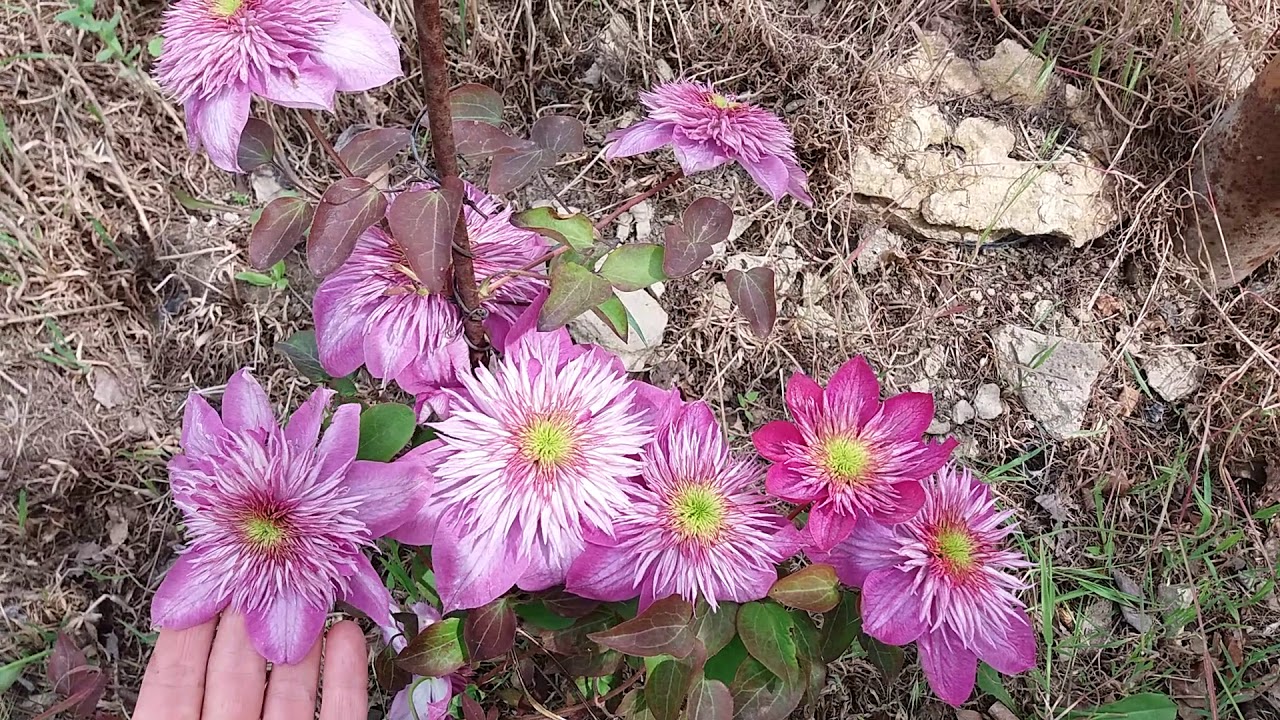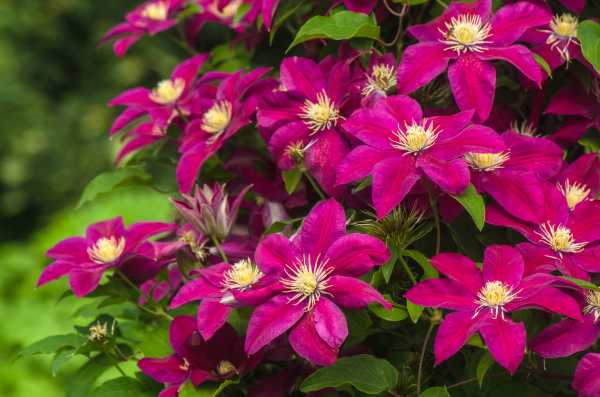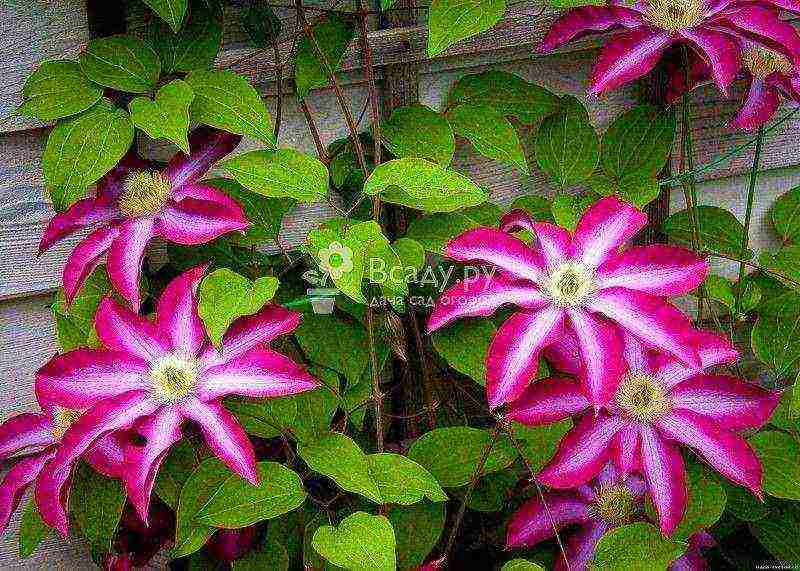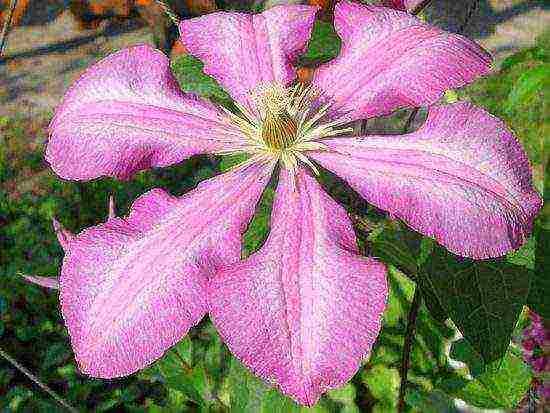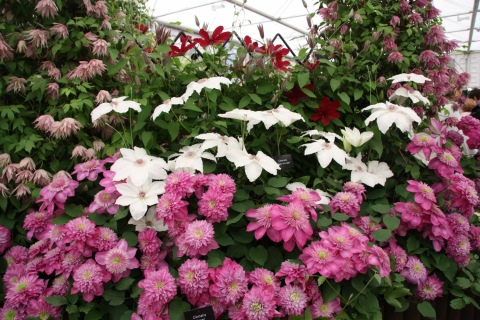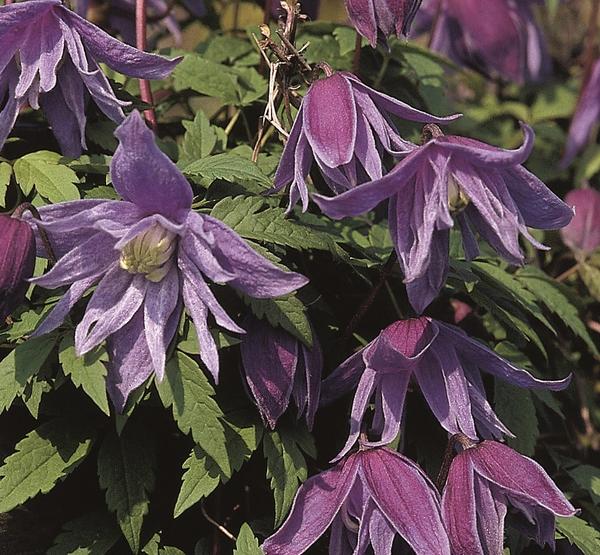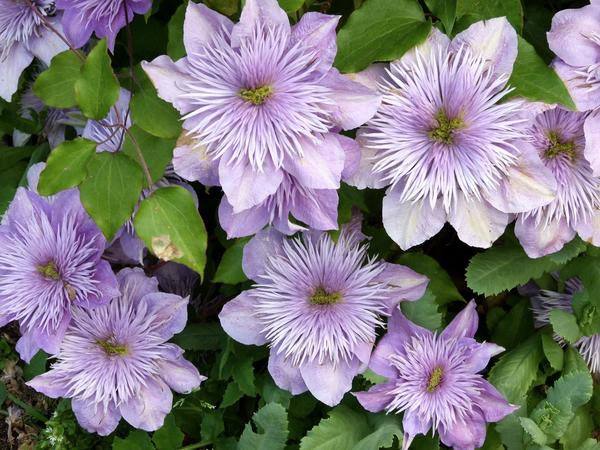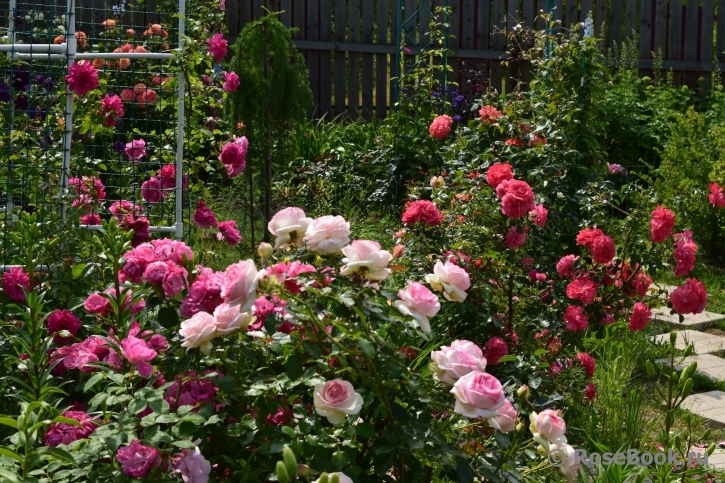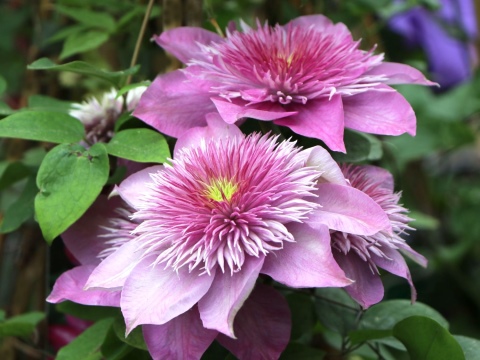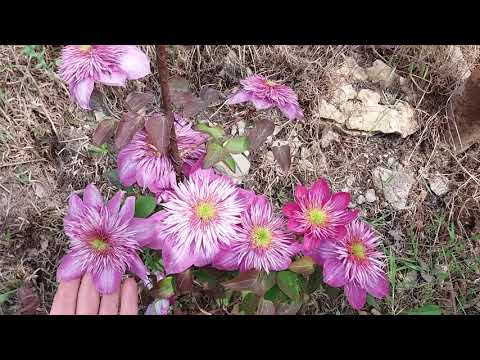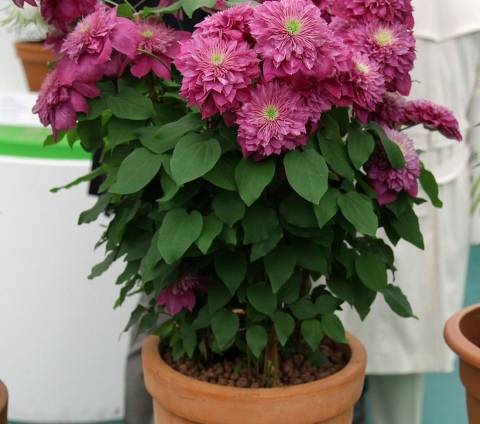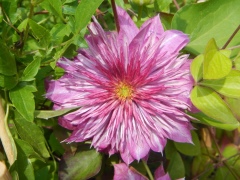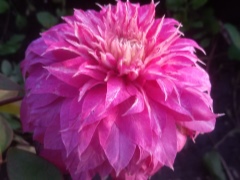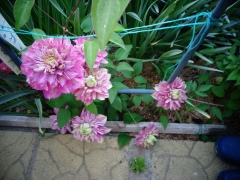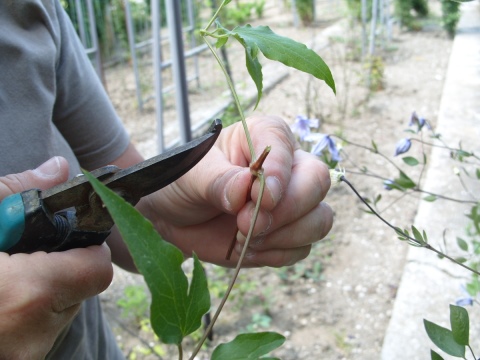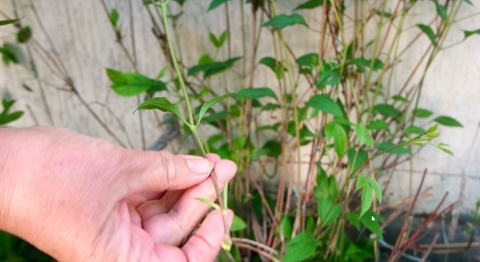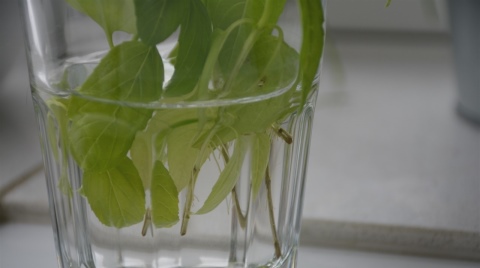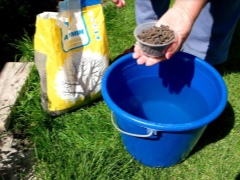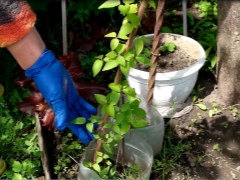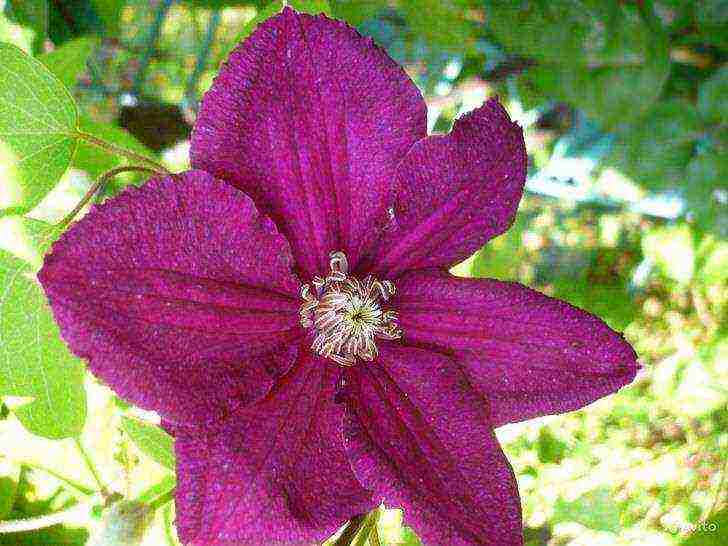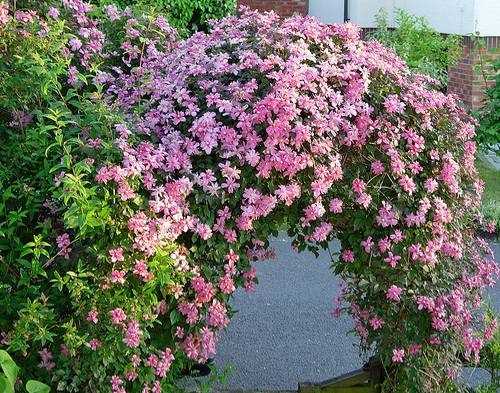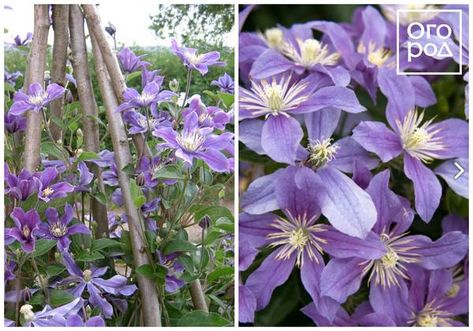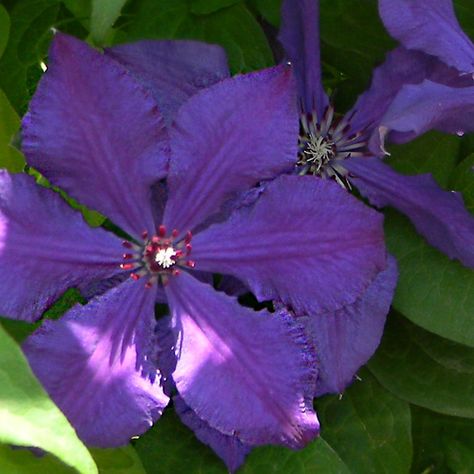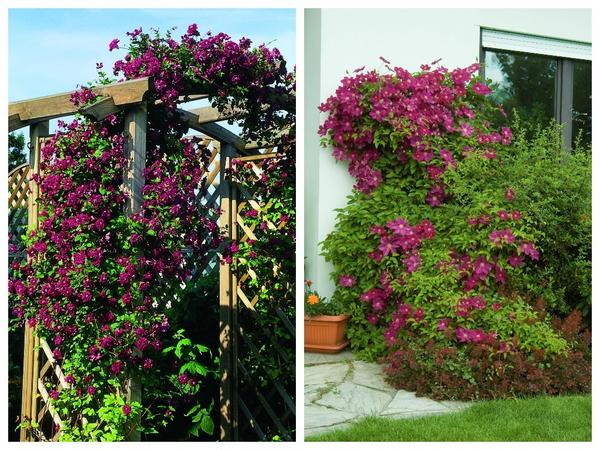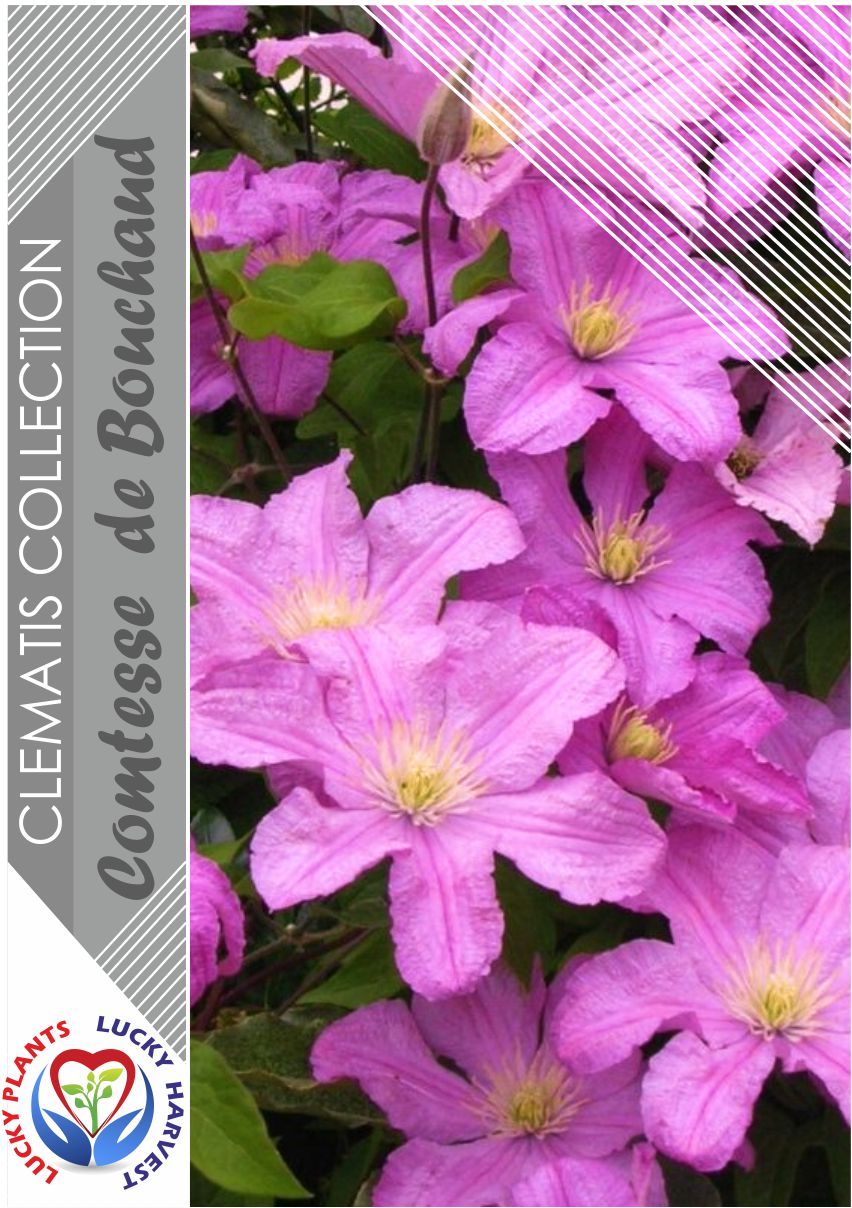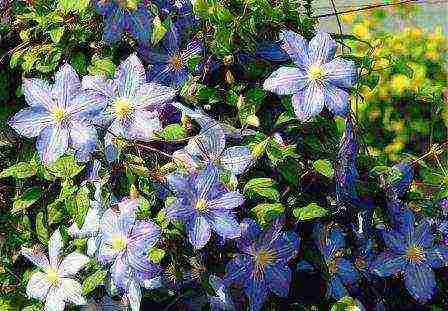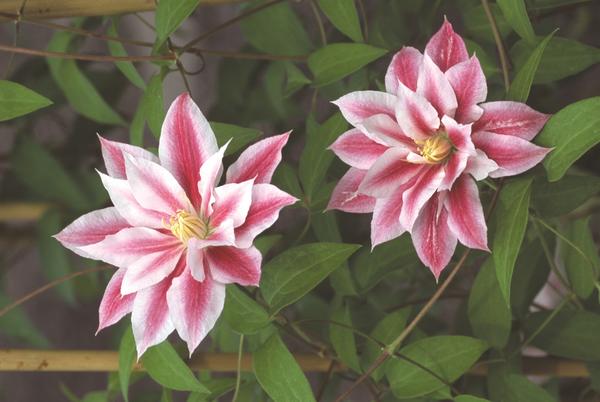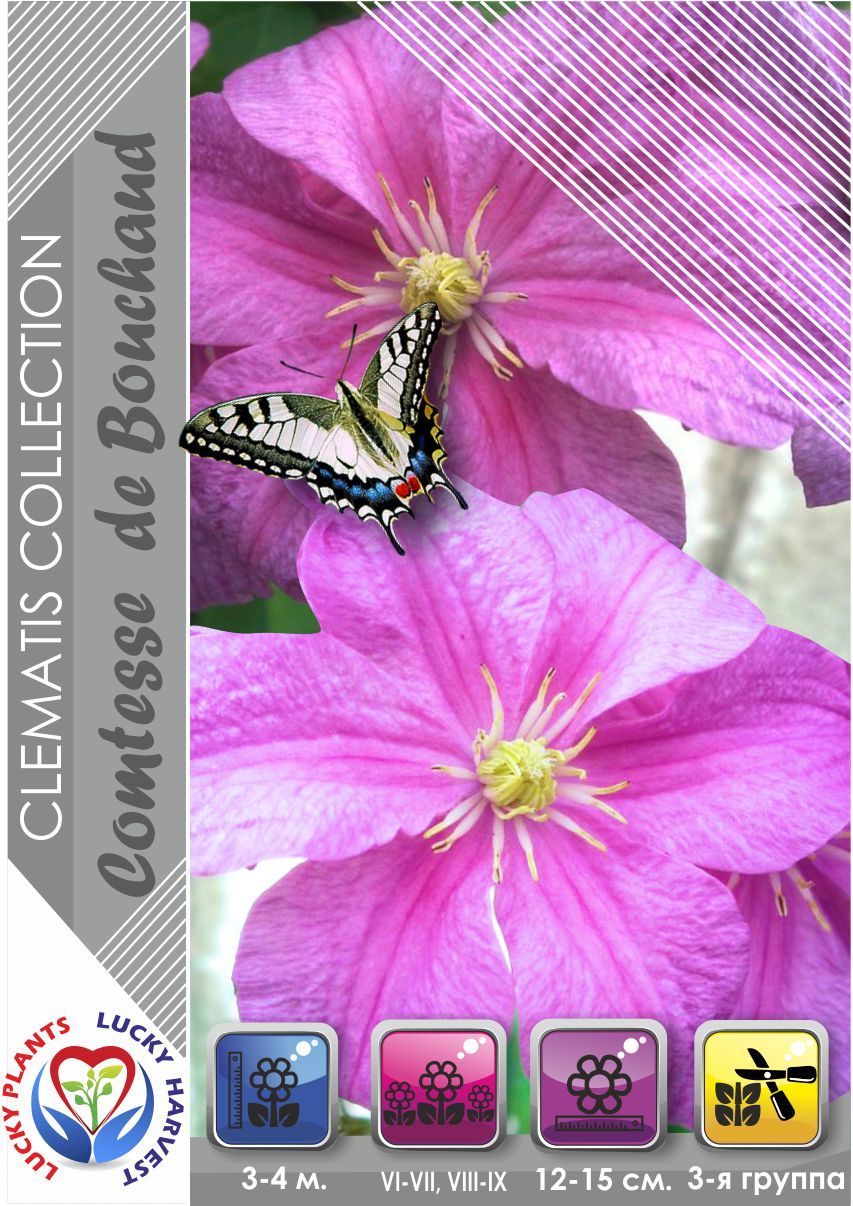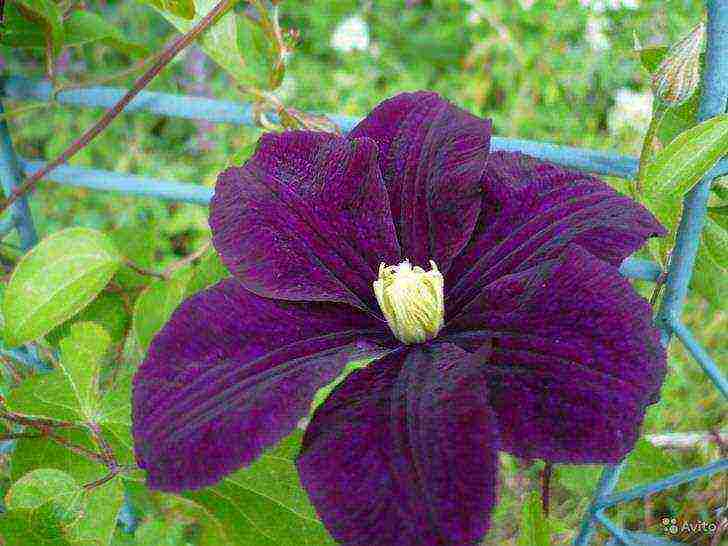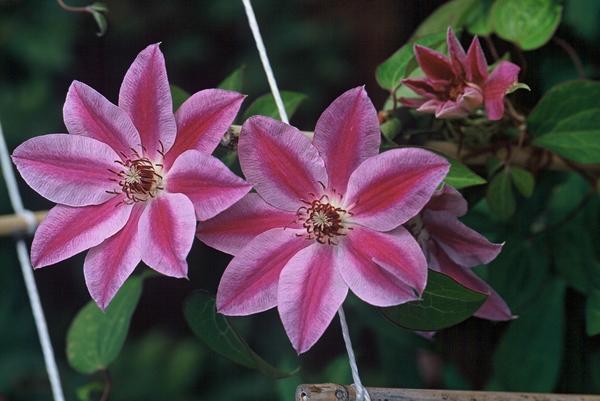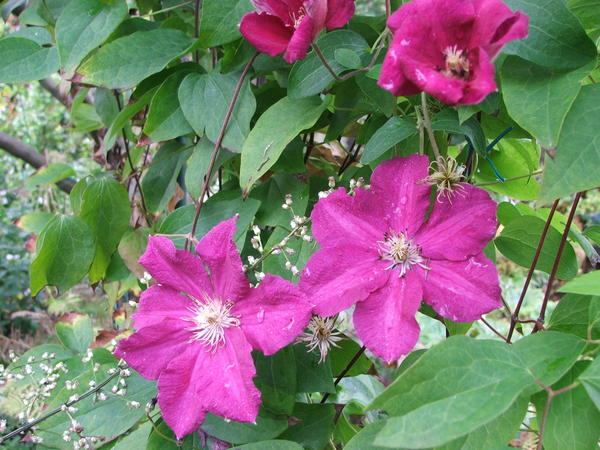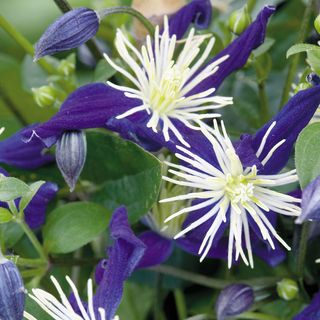Description
The plant is considered to be of medium height, its height is usually about 3 meters. During the season, it quickly gains green mass, forms a very large number of flowers, therefore it is often used not only to create compositions in combination with other plants, but also independently, for example, for decorating walls, masking individual buildings, and dense braiding of supports. However, it should be remembered that the plant will be able to cover large areas starting from the second year of life (in the first year, the vine will grow the root system). But a three-year-old clematis will be able to show its best qualities in full force. Liana can also grow without support and be used as a ground cover plant.
Clematis leaves are oblong, dark green, can reach a length of 10 cm. Both leaves and flowers form on the shoots of the current year very quickly. Many gardeners advise pinching the first inflorescences of newly planted plants in order to direct the forces of clematis to build up the root mass.
Flowers
Clematis flowers of this variety stand out among their "brothers". They are appreciated by lovers of the "retro" style in the design of their personal plot. The size of the flowers is small, 5-8 cm, but they are formed in huge quantities - subject to the rules of agricultural technology, there can be 100 or even 120 of them on one shoot. Flowers are double, voluminous, and consist of many layers of petals twisted to the outer edge. A distinctive feature is the complete absence of stamens.
The color is burgundy, purple. The outer side of the petal is lighter than the inner side. Buds are formed along the entire length of the vine.
Clematis of this variety begin to bloom in June and delight their owners with abundant and constant flowering until September, and even longer in the absence of frost.
Endurance
According to reviews, Clematis "Purpurea Plena Elegance" is considered quite hardy and unpretentious, suitable even for novice gardeners
The plant loves moisture, but does not tolerate its stagnation, therefore it is important to protect the vine from the proximity of groundwater and abundant melting of snow in the spring. The plant is not demanding on the composition of the soil, it should be light and contain drainage
Gardeners living in regions of risky farming, for example, in Siberia, confirm that the variety is able to withstand temperatures as low as -40 ℃. To do this, in the fall, the bushes are cut off completely and covered.
The plant is moderately susceptible to disease. Viruses do not affect clematis, but fungal infections can be observed on it: rust, wilt, gray rot, powdery mildew. Liana is especially susceptible to these diseases during wet summers. To an average extent, it is affected by pests such as a bear, a spider mite, a fly or a nematode.
Planting and leaving
The place for planting clematis should be sunny, it is better to avoid the north side. So that young shoots are not damaged and actively braid the support, you need to choose a site for clematis that is not blown by the winds.
A pit for planting a plant must be prepared in advance, it should not be less than 50 cm in all respects. Be sure to keep in mind that clematis do not like stagnant water and do not tolerate the proximity of groundwater. To protect the roots from decay in "damp" areas, you must first raise the soil level so that the water becomes farther from its surface. On such a "elevation" a hole is dug for planting a plant, and drainage is necessarily placed at the bottom of it.
Clematis loves water, so they need to be watered abundantly, at least 1 time per week, and in droughts more often - 2-3 times. Experienced gardeners advise shading the base of the plant to avoid overheating.The rest of the agrotechnical measures for this variety are standard: preventive treatments for diseases and pests, loosening or mulching of the soil, fertilization.
Trimming group
Clematis trimming group "Purpurea Plena Elegance" is the third. In autumn, the stems of the plant are cut off, 2-3 buds are left on each, that is, as much as possible. It is possible and completely cut off the stems, then next year the growth will occur only from the root buds left underground. In the latter case, you do not have to specially cover the plant, it will be enough just to sprinkle it with earth.
Care
The rules for caring for Clematis Nelly Moser are standard, but in order to get a beautifully flowering plant, they must be followed exactly.
Watering
If there is no hot and dry weather, watering is enough to do once a week.
It should be borne in mind that the roots of Clematis Nelly Moser are located close to the surface of the soil. Therefore, there is no need to use a large volume of liquid.
Watering is performed in the morning. On this day, in the evening, the soil can be mulched.
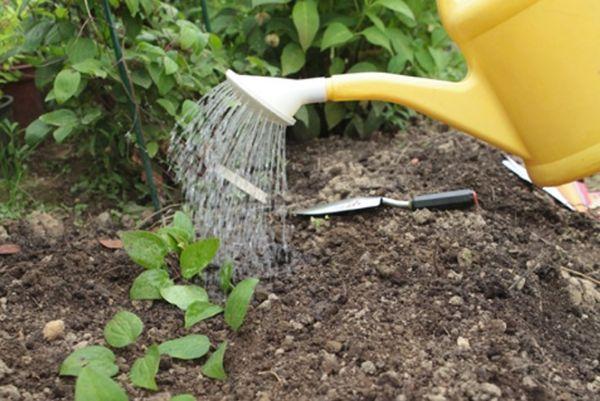
Top dressing
At the initial stage, in the spring, feeding is performed with organic matter. For this, an infusion obtained from a mixture of mullein and chicken droppings is suitable. To prepare it, it is enough to stir 1 liter of slurry in a bucket of water. The mixture is poured under the root of the flower.
When bud formation begins, a mixture of potassium and phosphorus fertilizers, taken in equal parts of 60 grams, is used for this purpose. It is repeated immediately after flowering ends.
Trimming group
Clematis Nelly Moser belongs to the second pruning group. To prepare for winter, the plant is cut to half the height. The procedure consists of two stages:
- After the first wave of flowering ends, last year's faded shoots are pruned.
- When the second wave is completed, young, faded shoots are pruned.
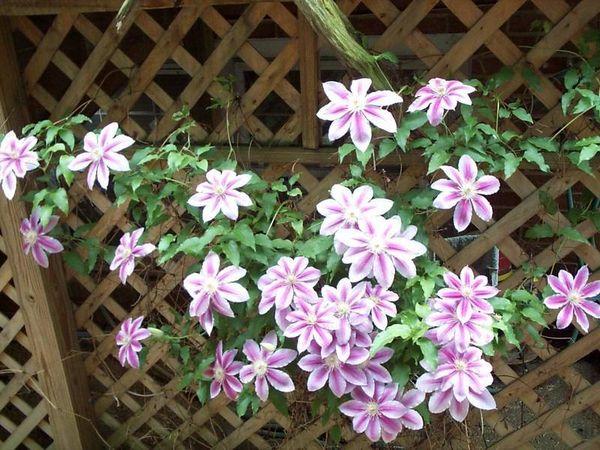
Shelter for the winter
If the soil is expected to freeze to a depth of 5 centimeters or more, then special measures must be taken for shelter during the frost.
The root system of Clematis Nelly Moser must be covered with peat, creating a small mound.
The lianas are rolled up in a ring and covered with agrofibre or pine branches.
Pests and diseases
In order for this flower to please the eye, it must not hurt. Here's what you need to do to protect it.
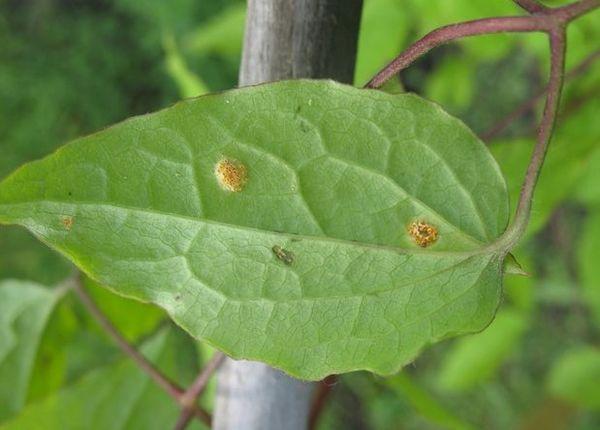
Wilt
Clematis Nelly Moser is vulnerable to wilt disease. If an infection has occurred, the diseased plant must be destroyed. After that, it is necessary to carry out tillage. To do this, it is treated with copper oxychloride or copper sulfate.
Powdery mildew
A powdery mildew remedy for this flower can be a soda solution. You can also use a composition of 30 grams of copper sulfate and 300 grams of laundry soap, dissolved in one bucket of water.
To fight rust, it is enough to treat the flower with a 2% solution of Bordeaux liquid.
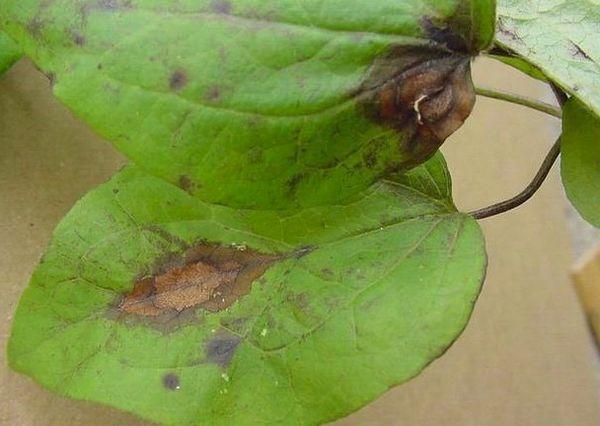
Ascochitosis
With this disease, dark spots appear on the leaves, they become fragile and easily damaged. If found, it is necessary to remove the damaged leaves and treat the flower with a solution of copper sulfate.
Loosening must be carried out after each watering. It is made at a shallow depth in order not to damage the roots. For mulching, peat or sawdust is poured around the vines
This is important to reduce evaporation and to protect the roots.
Features of the plant and agricultural technology
This is a shrub vine with large, double flowers, which are distinguished by their refinement of shape and an extraordinary variety of colors. By nature, the variety is better adapted to growing in warm climates, but it takes root well in central Russia as well. The bushes reach a height of 1.5-1.7 m (sometimes up to 2 m) and give a large number of lateral shoots bearing dark green leaves pointed at the ends.
 Large flowers (up to 14 cm in diameter) consist of several tiers of petals of various shapes
Large flowers (up to 14 cm in diameter) consist of several tiers of petals of various shapes
Clematis "Kaiser" blooms twice a season. The first buds appear in mid-late May on overwintered shoots of the last year. The second "wave" of flowering (on young stems) in temperate climates begins around mid-July and lasts until early October. The flowers are large (up to 14 cm in diameter), multi-layered, double. The shape of the petals varies from oblong-rounded in two or three outer rows, to needle-like closer to the center of the flower, which generally resembles a luxurious sea actinidia. The color of the petals is pink-scarlet with large white blotches, lilac and violet, much less often bluish. The cores of the flowers are bright or greenish yellow. In cool weather, the color of the petals may change and become light green. The flowering bush emits a pleasant smell, quite strong, but unobtrusive.
 In cool weather, the petals change color, becoming light green. Perfect for container culture
In cool weather, the petals change color, becoming light green. Perfect for container culture
Clematis "Kaiser" is planted according to the same rules as other clematis. The plant prefers calm, well-lit areas of southern, southeastern or southwestern exposure. It is advisable to position the bush so that it is not in direct sunlight all day. The culture does not like acidified soils and is afraid of stagnant moisture at the roots. Therefore, a layer of drainage material is usually poured at the bottom of the planting pit, and the composition of the soil with which it is filled is adjusted as necessary using alkalizing additives.
It is important that the "center of tillering" when planting was deepened by 10-15 cm
Clematis grows very quickly, and even at a very young age needs support. The trellis for the plant has to be built simultaneously with its planting.
When arranging a Kaiser sapling, the owner must take into account one important circumstance: when preparing for winter, the vine stems will not have to be cut, but removed from the support, trying not to damage them. Therefore, net or trellis trellis are not suitable for this type of clematis.
According to experienced gardeners, in this case, the support seems to be optimal, consisting of pieces of cord or twine, vertically or obliquely stretched on a wooden frame. In autumn, the upper part of the ropes is easy to cut, and the shoots intended for wintering should be carefully lowered to the ground.
 Shoots, abundantly covered with large massive flowers, need support, therefore, the trellis is built simultaneously with planting vines
Shoots, abundantly covered with large massive flowers, need support, therefore, the trellis is built simultaneously with planting vines
Caring for an adult plant consists in timely watering and feeding, weed control, shading the root zone with the help of plantings of low-growing annuals, as well as protection from pests and diseases. The "Kaiser" variety is considered to be quite "gentle". It can be affected by powdery mildew, wilt, various rot and alternaria, therefore, preventive treatments should not be neglected during cultivation.
Planting, pruning and care rules
In order for the plant to take root well and delight the gardener with abundant flowering for many years, it is necessary to correctly choose a place for it on the site. In the case of clematis "Ashva" planting is preferable in the sun or in light partial shade. In relation to buildings, it is better to choose a southern, southeastern or southwestern exposure. If the groundwater level on the site is high, you will have to place a bush on the highest place or even create something like a bulk flower bed for it. The planting hole should be immediately "filled" with organic fertilizer (best of all with humus or compost) and wood ash. They provide the plant with the nutrients it needs to strengthen its root system and build up green mass.
Before planting seedlings, organic fertilizers and wood ash are added to the prepared pits.
The ratio of the volume of "acidifying" and "alkalizing" additives must be adjusted taking into account the acidity of the soil
It is important to place the seedling in the hole in such a way that the root collar is buried at least 10-15 cm.If this is not done, the vine will develop slowly and give a very weak annual growth.
For clematis, planted at a distance from existing supports (walls, fence, pillar of a veranda or gazebo), you must immediately build a trellis.
Variety "Ashva" blooms on the shoots of the current year. This means that it belongs to the third group of trimming. In preparation for winter, all stems are shortened as much as possible, leaving only 2-3 nodes above the ground. In the middle lane, this is done in October. To protect the roots and underground "buds of growth" from freezing, the soil under the plant is covered with a thick layer of mulch (in the optimal version - peat or humus, which in the future will also play the role of fertilizer). Light shelters are built only in cases where the site is located in a region with a very harsh climate.
Clematis "Ashva" belong to the third pruning group, that is, in the fall, all stems are cut radically, and in the spring - sanitary, removing weak and damaged shoots
Safely overwintered clematis in the spring are rapidly growing. At this time, sanitary pruning is carried out, removing damaged and weak shoots. Summer care is mainly about removing weeds and protecting the root system from overheating. Plants prefer deep soil moisture: watering may not be very frequent, but each bush should get at least 20-30 liters of water. To keep the soil moist, it is mulched or sown with low-growing annuals (flowers or lawn grass). In most cases, adult clematis calmly tolerate the lack of annual feeding and need fertilization only when grown on very poor soils. The variety is slightly affected by diseases and pests. He needs protective measures relatively rarely.
Compact bushes of clematis "Ashva" are perfectly combined with tall varieties of crops and other flowers, such as roses
According to gardeners, Clematis "Ashva" is perfect for decorating low supports (for example, stone walls) or growing as a central element of flower beds. It can be planted at the foot of taller vines, creating beautiful compositions with vertical or horizontal color transitions. The plant has shown itself perfectly as a container culture: it is widely used in landscaping loggias, balconies, verandas and patios.
Planting material for clematis "Ashva" is offered by many manufacturers in Russia and other post-Soviet countries
Description of Clematis Kaiser
Liana grows up to 1.5 m in height, actively lets out lateral processes. It has carved leaves of a dark green color, which are pointed at the ends, have the shape of an ellipse. The buds on clematis of the Kaiser variety appear for the first time in the spring, the second - at the beginning of summer.
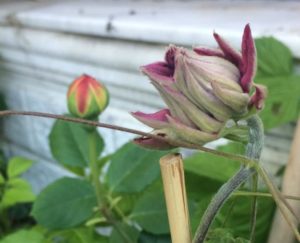
In May and June, the climbing liana is covered with double flowers, the diameter of individual specimens reaches 14 cm.
Wide or needle-like clematis petals have different colors:
During a cold snap, flowers with yellow cores acquire an amazing greenish tint. The petals are covered with white specks. In July and August, fewer buds appear on the plant, but flowering continues until October.
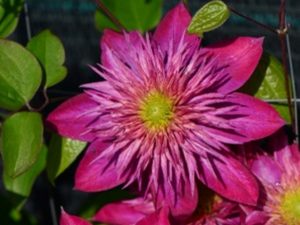
Hybrid Clematis Kaiser is supported by a support. Its features:
- Loves warmth.
- Does not tolerate stagnant water.
- Requires a lot of light.
- Reacts negatively to temperature jumps.
Although it is not easy to grow a vine created in Japan, it can withstand the frosty winters of mid-latitudes.
The appearance of an exotic liana, strewn with blooming buds, won the hearts of many gardeners. Photo and description of clematis Kaiser is not able to convey the play of shades of double flowers.
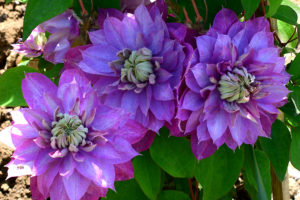
The plant responds to care by the appearance of many opening buds. It takes a lot of work to see this miracle.
Related videos
You can learn more about clematis of the third trimming group from the following video:
Mom, wife and housewife, lawyer and accountant all rolled into one. He never stops at what has been achieved and strives to gain new knowledge in various fields. I am pleased to share with readers my discoveries in the field of gardening.
Found a bug? Select the text with the mouse and click:
Oklahoma farmer Carl Burns has developed an unusual variety of colorful corn called Rainbow Corn. The grains on each ear are of different colors and shades: brown, pink, purple, blue, green, etc. This result was achieved through many years of selection of the most colored common varieties and their crossing.
It is believed that some vegetables and fruits (cucumbers, stalk celery, all varieties of cabbage, peppers, apples) have a "negative calorie content", that is, digesting more calories than they contain. In fact, the digestive process uses only 10-20% of the calories from food.
Natural toxins are found in many plants; those that are grown in gardens and orchards are no exception. So, in the seeds of apples, apricots, peaches there is hydrocyanic (hydrocyanic) acid, and in the tops and peel of unripe nightshades (potatoes, eggplants, tomatoes) - solanine. But do not be afraid: their number is too small.
From varietal tomatoes you can get "your" seeds for sowing next year (if you really like the variety). And it is useless to do it with hybrid ones: the seeds will turn out, but they will carry the hereditary material not of the plant from which they were taken, but of its numerous “ancestors”.
One of the most convenient methods to prepare a grown crop of vegetables, fruits and berries is freezing. Some people believe that freezing leads to a loss of the nutritional and beneficial properties of plant foods. As a result of the research, scientists have found that there is practically no decrease in nutritional value when frozen.
In small Denmark, any piece of land is a very expensive pleasure. Therefore, local gardeners have adapted to growing fresh vegetables in buckets, large bags, foam boxes filled with a special earthen mixture. Such agrotechnical methods allow you to get a harvest even at home.
Compost - rotted organic residues of various origins. How to do it? Everything is stacked in a heap, a hole or a large box: kitchen leftovers, tops of garden crops, weeds mown before flowering, thin twigs. All this is interlayered with phosphate rock, sometimes with straw, earth or peat. (Some summer residents add special composting accelerators.) Cover with foil. In the process of overheating, the pile is periodically ted up or pierced for the flow of fresh air. Usually compost “matures” for 2 years, but with modern additives it can be ready in one summer season.
Convenient Android applications have been developed to help gardeners and gardeners. First of all, these are sowing (lunar, flower, etc.) calendars, thematic magazines, a selection of useful tips. With their help, you can choose a day favorable for planting each type of plant, determine the timing of their ripening and harvest on time.
It is necessary to collect medicinal flowers and inflorescences at the very beginning of the flowering period, when the content of nutrients in them is as high as possible. Flowers are supposed to be picked with hands, breaking off rough pedicels. The collected flowers and herbs are dried, scattered in a thin layer, in a cool room at a natural temperature without access to direct sunlight.
Planting and leaving
Planting Clematis Kaiser and caring for it will require skill and experience from the gardener.
The heat-loving clematis of the Kaiser variety is planted at the end of May, when the threat of return frosts has completely passed.
For planting the Kaiser variety, well-lit and wind-protected places are chosen.The variety prefers loose, fertile soils with neutral acidity or slightly alkaline.
Prepare for landing in advance. Supports or grates should be ready by the time of planting. Kaiser clematis shoots grow quickly, but in the first year they are weak and fragile, and need a timely garter.
- A planting pit is made at least 50-70 cm deep and of the same diameter.
- First, a drainage layer of 10-15 cm is arranged using broken brick, crushed stone, small stones. A drainage device is mandatory in conditions close to the surface of groundwater.
- Next, a layer of fertile soil up to 20 cm high is poured. The poorer the soil, the more mixture of humus and garden soil is laid in the hole. Mix in up to 100 grams of superphosphate and wood ash.
- The supports are installed in the pit and fixed well.
- The roots of the plant are soaked for several hours in a growth stimulant solution.
- Clematis of the Kaiser variety is planted on a small mound of garden soil, poured into a hole. The root collar is deepened by 5-10 cm.
- Fall asleep with soil, forming a root club up to 5 cm deep.
- The seedling is immediately cut off, leaving 2-4 buds, and shaded a little.
- Water and mulch the root circle with bark or sawdust.
On a note!
It is preferable to plant Kaiser clematis on cloudy days.

To obtain a good result when growing Kaiser clematis, the following rules are followed.
- Timely watering. How to determine its timeliness? The soil in the root circle should dry out to a depth of 7-10 cm. Water abundantly, up to 10 liters of warm, settled water under one plant. Do not allow water to enter the leaves.
- After each watering, the soil is loosened and the soil is gradually added. By the fall, a 5-10 cm high slide should form at the clematis stem.
- Once a week, clematis of the Kaiser variety are fed with complex special fertilizers for vines or flowering plants.
- Young shoots are tied up every 4-5 days. More often this has to be done in the first year of the flower's life.
One of the important points for preserving clematis of the Kaiser variety is the correct organization of its wintering. Preparations begin in the first half of October. First, the root zone is covered with a mixture of peat and dry leaves, sawdust or needles. When the temperature drops to 0˚ + 2˚C, the shoots are carefully laid and covered with spruce branches on top or again covered with a 3-5 cm layer of the same mixture of peat and scrap materials. Next, clematis Kaiser is covered with a non-woven covering material.
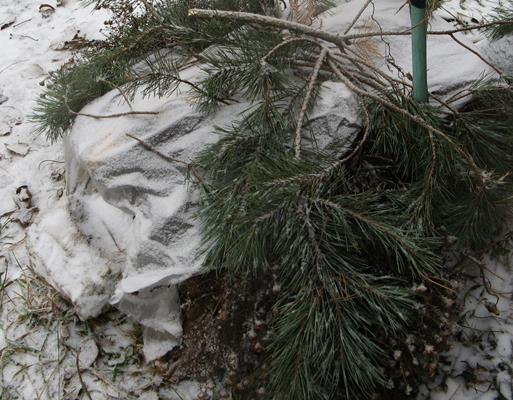
If possible, do not use film. If there is no other covering material at hand, small holes are made in the film for free air access. With the onset of cold weather, additional shelter is installed from wooden boxes or flooring with straw or sawdust. In spring, the plant is opened gradually.
Care secrets
Liana of the described variety is considered not too demanding to care for.
In order for her to feel good and tirelessly delight her owner with lush flowering, the gardener must pay special attention to the following basic activities:
- top dressing;
- watering;
- loosening and mulching.
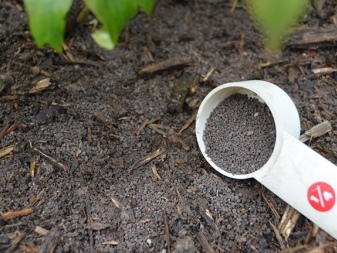
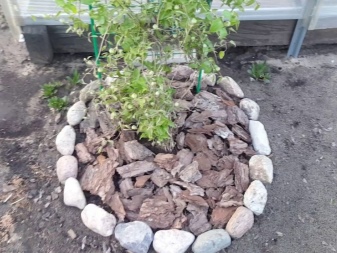
Top dressing
In order for the liana of the "Doctor Ruppel" variety to bloom profusely and for a long time, it needs regular feeding. The active formation of green mass and buds depletes these sensitive perennials, depriving them of their strength and immunity. Starting in May, when clematis enter the phase of flowering and intensive formation of shoots, they should be fed with some kind of fertilizer once every 7-10 days. Usually, gardeners use complex preparations for fertilizing:
In the fall, it is recommended to feed the vines with the following composition:
- 10 liters of water;
- 20 g superphosphate;
- 20 g of potassium sulfate.
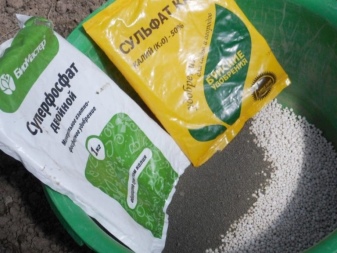
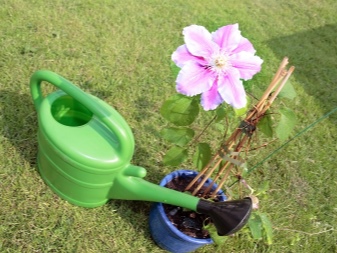
Such a nutrient solution will restore the strength of the plant after flowering and allow it to fully prepare for the upcoming winter.At the same time, the vines will begin to spend part of the unused nutrients received with the solution already in the spring, entering the phase of active growth and budding ahead of schedule. After spring pruning, it is recommended to feed the Doctor Ruppel vine with a solution of ammonium nitrate (60 g of substance per 10 liters of water). The solution is consumed at the rate of:
- young plants - 5 liters per well;
- adult plants - 10 liters per well.
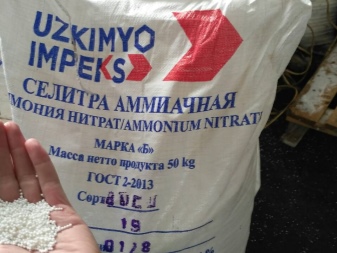
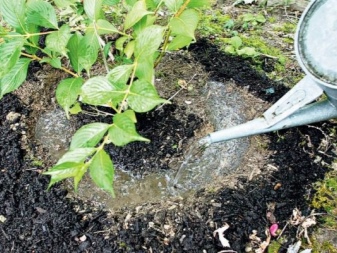
Watering
Like all clematis, the Doctor Ruppel variety painfully tolerates moisture stagnation in the soil, so you should not abuse watering (especially in cool and damp weather). Waterlogging of the soil often causes fungal root diseases, from which this garden vine can die.
In a moderately hot summer, it is enough to water the clematis once every 8-10 days. If the summer is extremely hot, you need to water the vines 2 times every 8-10 days. One plant should consume from 10 to 30 liters of water (depending on the age and size of the vine). Watering is carried out so that splashes of water do not fall on the leaves, shoots and stems of the plant. After watering the ground around the base of the bush mulch.


Loosening and mulching
Regular loosening of the soil around the base of the bush will provide oxygen access to the roots of clematis
Loosening the soil should be done with the utmost care, without deepening the teeth of the tool, so as not to damage the roots located close to the ground
In addition, due attention should be paid to mulching the soil. Experienced gardeners use as mulch:
They are scattered in an even, not too thick layer around the base of the bush. You can plant annual ground covers in a clematis hole, which will replace the mulching layer. All these measures will help to protect the roots of Clematis variety "Doctor Ruppel" from overheating, and at the same time will help prevent moisture loss in the soil.
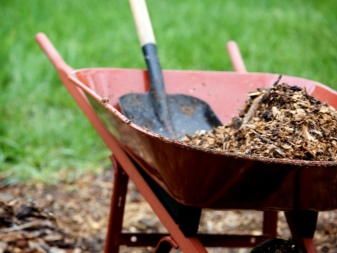
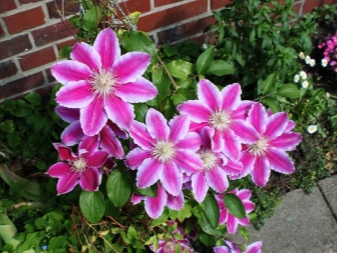
For how best to plant clematis, see the next video.

Origin and characteristics of the plant
Clematis Ashva was bred in Lithuania in 1990-92. The author is the renowned breeder Lejnardas Bakevicius. The variety first went on sale in 1998. In 2004 he exhibited in the Netherlands at the Plantarium international exhibition, where he was awarded a bronze medal.
The prestigious international trade fair for plant growers Planarium is held annually in Boskoop (Holland)
Opinions differ as to the place of this clematis in the classification adopted in Russia. Some sources attribute him to the "Zhakman" group, others - to the "Patens" group. The plant is low (no more than 2 meters), compact, large-flowered, medium-late flowering. In the middle lane, the bushes of "Ashva" begin to bloom at the end of June, and end at the beginning of September. In warmer regions, the variety retains its decorative effect from late May to October. It can be successfully cultivated in areas of "risky farming", since flower buds are formed quite late and do not fall under spring frosts. The root system can withstand a short-term drop in temperature to -30 degrees, but when grown in a harsh climate, it needs mulching for the winter. The variety is considered unpretentious and resistant to the most common diseases.
On an adult bush, abundant flowering and constant laying of new buds occur at the same time
Clematis bush "Ashva" in the photo looks very impressive. The flowers of the variety are not the largest (diameter does not exceed 8-9 cm), but surprisingly graceful and noble. Petals are usually 6-7. They have a rounded shape and delicate, wavy edges. The main color is purple-violet. In the center of the petal there is a bright crimson longitudinal stripe, the color of which is smoothly "blurred" towards the edges. The stamens are very light, almost white; anthers dark purple. An adult plant can simultaneously have up to 100 blossoming flowers and not yet opened pointed buds.With normal care, the plant reaches its maximum decorative effect in the third year of life.
The color of the petals is predominantly purple-violet with a bright crimson, blurred at the edges, a longitudinal stripe in the center



